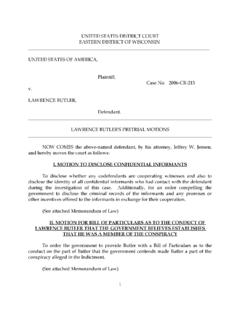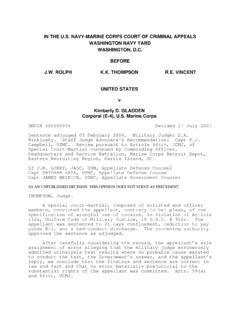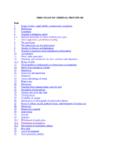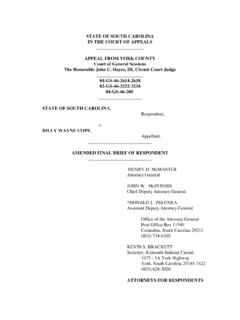Transcription of Summary of Contents - alabamaduihandbook.com
1 Summary of ContentsChapter O enseChapter Jurisdiction and VenueChapter Driver's License SuspensionsChapter Stop, Reasonable Suspicion, and ArrestChapter and Probable CauseChapter Sobriety TestingChapter Consent and Prealcohol-Test IssuesChapter Alcohol TestingChapter InstrumentsChapter 10. Law O ce Management and TechnologyChapter 11. DiscoveryChapter 12. Pretrial MotionsChapter 13. The TrialChapter 14. Evidentiary IssuesChapter 15. Special DefensesChapter 16. SentencingChapter 17. Posttrial MotionsTable of Laws and RulesTable of CasesIndexxxiTable of ContentsCHAPTER 1. THE OFFENSE 1:1 Alabama DUI law 1:2 Actual physical control 1:3 Per se violation; .08% BAC or greater 1:4 Under the in uence of alcohol 1:5 Under the in uence of a controlled substance 1:6 Under the combined in uence of alcohol and a controlledsubstance 1:7 Under the in uence of any substance which impairs themental or physical faculties of such person to a degreewhich renders him or her incapable of safely driving 1:8 Underage DUI 1:9 Underage over.
2 02% BAC charge 1:10 Underage rst o ense BAC between .02 and .08% 1:11 Underage BAC over .08% 1:12 Underage multiple o ender 1:13 Underage no BAC/refusal 1:14 Illegal consumption 1:15 School bus or day care driver 1:16 Commercial vehicle 1:17 Statutory sentencing guidelines 1:18 Boating under the in uence 2. COURT JURISDICTIONAND VENUE 2:1 Generally 2:2 State of Alabama court system The judicial article 2:3 DUI jurisdiction Misdemeanor DUI 2:4 Police jurisdiction arrests 2:5 Special constitutional provisions 2:6 Section 89, Ala Const 1901 2:7 Municipal ordinances Inclusion of a felony 2:8 Felony DUI 2:9 Federal DUI 2:10 Venue Proof of venue is jurisdictional 2:11 Alabama Code of Criminal Procedurexxiii 2:12 More than one countyCHAPTER 3. ADMINISTRATIVEDRIVER'S LICENSE SUSPENSIONS 3:1 Generally 3:2 Implied consent 3:3 Per se suspension (over.)
3 08) 3:4 Refusals 3:5 Administrative review 3:6 Administrative hearing 3:7 Judicial review 3:8 Stay orders 3:9 Section Q appeals 32-5A-195(q) 3:10 DUI controlled substances 3:11 Suspension for points accumulation 3:12 Other driver's license suspensions Fleeing and eluding 3:13 Leaving the scene of an accident 3:14 Commission of a felony 3:15 Cancellation, suspension, or revocation under 32-5A-195 3:16 Commercial driver's license issues 3:17 The AST-60 3:18 Letter requesting administrative review of suspensionorder 3:19 Petition requesting a stay of suspension order 3:20 Another petition 3:21 Request for an administrative hearing 3:22 Subpoena 3:23 Results of administrative review letter 3:24 Petition for judicial review of suspension orderCHAPTER 4. THE STOP, REASONABLESUSPICION, AND ARREST 4:1 Reasonable suspicion and the Fourth Amendment 4:2 Routine tra c stop 4:3 National Highway Tra c Safety Administration(NHTSA) guidelines on detection of DUI o enders atnight 4:4 Speeding 4:5 Determination of speed by pace 4:6 Determination of speed by radar 4:7 Weaving/improper lane usage 4:8 Running a red lightxxiv 4:9 High-crime area 4:10 Pretextual stop 4:11 Investigatory stop 4:12 Mistake of law/fact 4:13 Community caretaking function 4:14 Sleeping in car 4:15 Urinating beside the vehicle 4:16 Stopped vehicle 4:17 Improperly parked car on highway 4:18 Approaching a stopped vehicle 4:19 Ordering persons out of the car 4:20 Ordinance parking in violation 4:21 Disabled vehicles 4:22 Prohibited stopping 4.
4 23 Failure to use turn signal 4:24 Driving too slow 4:25 Failure to wear a seatbelt 4:26 Accidents 4:27 Actual physical control 4:28At the scene exception to 32-5-171 4:29 Accident report privilege 4:30 Corpus delicti 4:31 Improper lights 4:32 Tra c control devices 4:33 Stop bar 4:34 Uniform tra c control device manuals 4:35 Tipster cases Anonymous tipsters 4:36 Citizen tipsters 4:37 Police tipsters/fellow o cer rule 4:38 Roadblocks Constitutionality, generally 4:39 Supreme Court cases 4:40 Alabama cases 4:41 Alabama cases Avoiding roadblocks and reasonablesuspicionCHAPTER 5. ARREST AND PROBABLECAUSE 5:1 Reasonable suspicion and probable cause 5:2 Consequences of illegal arrest 5:3 Excessive force 5:4 Arrest outside jurisdictionTable of ContentsxxvCHAPTER 6. FIELD SOBRIETYTESTING 6:1 Field sobriety testing Generally 6:2 The 1977 NHTSA study 6:3 The 1981 study 6:41983 NHTSA study 6:5 NHTSA validation studies 6:6 The Colorado validation study: A Colorado ValidationStudy of the Standardized Field Sobriety Test (SFST)Battery 6:7 San Diego, California, validation study: Validation ofthe Standardized Field Sobriety Test Battery at BACsBelow Percent 6:8 The Florida validation study: A Florida ValidationStudy of the Standardized Field Sobriety ( )Battery 6:9 Discussion of validation studies 6:10 The NHTSA manuals 6:11 NHTSA student manual on SFST 6:12 Session VIII of the NHTSA student manual 6:13 NHTSA student manual changes to session VIII 6:14 Fear and eld sobriety 6:15 Alabama case law on eld sobriety tests 6.
5 16 Other roadside tests 6:17 ABCs 6:18 Count backwards 6:19 Finger count 6:20 Finger to nose 6:21 ScoringCHAPTER 7. IMPLIED CONSENT ANDPREALCOHOL-TEST ISSUES 7:1 Generally 32-5-192 7:2 Serious physical injury or death 7:3 Public road 7:4 Driving vs. actual physical control 7:5 Lawful arrest required 7:6 Implied consent and administrative driver's licensesuspensions 7:7 Right to independent blood alcohol test 7:8 Deprivation/observation periodxxviCHAPTER 8. BREATH ALCOHOLTESTING 8:1 Generally 8:2 Absorption, distribution, and elimination 8:3 Breath alcohol-testing principles 8:4 Henry's law of gases 8:5 Law of absorption Beer-Lambert law 8:6 Electrochemical fuel cell 8:7 Nonspeci city 8:8 The history and legislative purpose of the Department ofForensic Sciences 8:9Ex parte Marvin Mayoand the statutory predicate 8:10 The search for a new device 8:11 DFS vs.
6 John Randall Isbell 8:12 Public Records Act Ala. Code 1975 36-12-40 8:13 The Drager 7110 MKIII-C How it works 8:14 Defense issues Speci city 8:15 Mouth alcohol 8:16 Rising blood alcohol 8:17 Contaminated sample 8:18 Gastric esophageal re ux disease ( ) 8:19 Tyndall e ect 8:20 Linearity 8:21 Radio frequency interference (RFI) 8:22 Source code 8:23 What is source code? 8:24 Source code sources 8:25 Two types of source code providers 8:26 States of source code litigation 8:27 Government issues about production 8:28 Types of source code defects 8:29 Something wrong here 8:30 DFS Rules for breath testingCHAPTER 9. CHARGING INSTRUMENTS 9:1 Uniform tra c ticket and complaint 9:2 Improperly veri ed UTTC 9:3 Alternative methods of charging the same o ense 9:4 Failure to state a cause of action 9:5 Proceedings 9:6 Indictments and information 9:7 WarrantsTable of Contentsxxvii 9:8 Interpreting a municipal ordinanceCHAPTER 10.
7 LAW OFFICEMANAGEMENT AND TECHNOLOGY 10:1 Introduction 10:2 Hiring employees 10:3E ective use of resumes for screening candidates 10:4O ce interviews: the family approach 10:5 New employees: qualifying tests 10:6 What to pay new employees 10:7 Creating job descriptions 10:8 Employee training 10:9 The employee handbook for small rms 10:10 Law o ce nances: attorney and client 10:11 Contracts 10:12 Promissory notes 10:13 Use of credit cards and debit cards 10:14 Cash payments 10:15 Computer backups in the technology age 10:16 Checks 10:17 The client le 10:18 Client communications: timeline letters 10:19 Advising the client about discovery procedures 10:20 Advising the client about the need for a privateinvestigator 10:21 Suspension letters received by the client from thelicensing authority 10:22 Administrative suspension hearing 10:23 Explain operation of court system to client 10:24 Client intake questionnaires 10:25A good points/bad points form 10:26 Pretrial letters 10:27 Case management 10:28 Plea advice and consent form 10:29 Case disposition form 10:30 Video analysis form 10:31 Expert witnesses 10:32 Witness questionnaires 10:33 Ideas for the small law o ce 10:34 Telephone system 10:35 Attorney documents 10:36O ce calendarsxxviii 10:37 End of the year project time 10:38 Court locations 10:39 Attorney's documents as regular business records 10:40 Client notice letters 10:41 Conclusion: The attorney's transition planCHAPTER 11.
8 DISCOVERY 11:1 Discovery, generally 11:2 Constitutional right to discovery TheBradyrule: reliefof favorable evidence suppressed 11:3 TheKylesrule: imputed knowledge 11:4 Alabama public records 11:5 Breath testing records 11:6 DUI statutory request, 32-5A-194(a)(4) 11:7 Local rule(s) 11:8 Protective orders and conditions of discovery 11:9 Relief for noncompliance Rule ARCrP 11:10 Depositions 11:11 Subpoenas Rule 17 ARCrP 11:12 Access to witnesses 11:13 Discovery by the prosecutionCHAPTER 12. PRETRIAL MOTIONS 12:1 Motion practice General requirements Rule ARCrP 12:2 Motions to suppress (Rule ARCrP, Rule (a),ARCrP) 12:3 Motions to suppress Burden of proof 12:4 E ect of granting (Rule (d), ARCrP) 12:5 Objections and defenses required by pretrial motion(Rule , ARCrP) 12:6 Time of making motions under rule , ARCrP 12:7 Applicability of the Alabama Rules of Evidence tomotion hearings (Rules 1101 and 104 ) 12:8 DUI issues to address by pretrial motions 12:9 Statements 12:10 Recordings 12:11 Chemical tests 12:12 Sample motionCHAPTER 13.
9 THE TRIAL 13:1 The trial de novo systemTable of Contentsxxix 13:2 Jury trial 13:3 Selection of the jury in a DUI case 13:4 Initial considerations 13:5 Number of jurors 13:6 Know the process 13:7 General considerations and purposes for voir dire 13:8 Getting to know the jury 13:9 Relaxing the jury 13:10 Overcoming lawyer credibility 13:11 Education 13:12 Introducing the theme 13:13 Preparation for voir dire 13:14 Eenie, meenie, minie moe 13:15 Juror pro le 13:16 Jury selection 13:17 Challenge for cause 13:18 Peremptory challenge 13:19 Batsonchallenge 13:20 Juror questionnaire 13:21 Procedure for selection 13:22 Opening statement (Rule , ARCrP) 13:23 Cross-examination in general 13:24 Motion for judgment of acquittal (Rule 20, ARCrP) 13:25 Questions from judge (Rule , ARCrP) 13:26 Questions by the jury 13:27 The defense presentation 13:28 Taking the Fifth 13:29 Demonstrative evidence 13:30 Closing argument 13:31 Objections for improper argument 13:32 Pattern jury instructions 13:33 Mandatory rebuttable presumption 13:34 Adverse inference rule 13:35 Requested jury instructions 13:36 Jury questionnairesCHAPTER 14.
10 EVIDENTIARY ISSUES 14:1 Generally: Alabama Rules of Evidence Applicability 14:2 Character evidence 14:3 Prior bad acts (Rule 404 (b)) 14:4 Prosecution required to give notice 14:5 Defense objection to adverse ruling based on 404(b)xxx 14:6 Habit 14:7 Hearsay 14:8 Recordings Predicate 14:9 Opinion evidence 14:10 Proof of municipal ordinances 14:11 Municipal ordinances: rules on proper passage 14:12 Right to record proceedings 14:13 Sturgeonrule of exclusion 14:14 Field-sobriety tests 14:15 Predicate 14:16 Pass/fail 14:17 Horizontal gaze nystagmus (HGN) 14:18 Alco-Sensor 14:19 Completeness doctrine 14:20 Preservation of evidence doctrine etc 14:21 Toxicology reports 14:22 Controlled substance 14:23 Breath test certi cate of analysis 14:24 Expert and opinion testimony 14:25 Videotape admissibility 14:26 Proof of driving record to prove driver's license status 14:27 Admissibility of computer printout 14:28 Refreshing memory 14:29 Polygraph 14:30 Prosecutor vouching for credibility of witness prohibited 14:31 Corpus delictiCHAPTER 15.






